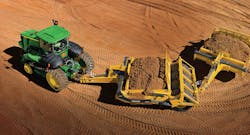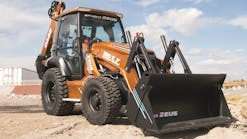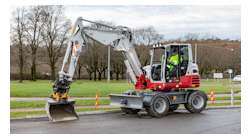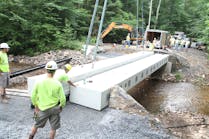In Part 1 of this series on excavator attachments for demolition, author Ed Ritchie explores how grading and excavation contractors can increase revenue by offering demolition services. In this article, we continue our look at demolition attachments offered by other construction equipment manufacturers.
Gehl is another earthmoving manufacturer that offers a full line of demolition attachments. The company, based in West Bend, WI, offers a demolition attachment line that includes augers, breakers, buckets, compaction plates, frost rippers, grapples, pavement removal buckets, and thumbs. Many of the demolition attachments will find use on Gehl’s new Z80 Compact Excavator. The machine features an advanced hydraulic system designed to enhance engine performance, resulting in a more efficient system.
At Kubota Tractor Corp., Torrance, CA, attachments play a major role in the company’s product offering, but Kubota also looks at remediation as an important task in the process. In mid-2014, Kubota announced availability of its new Hydraulic 6-in-1 Blade for the KX040-4 Compact Excavator. With six different positions, it makes leveling and backfilling, even on inclines and uneven terrain, faster and easier, for improved efficiency and greater productivity. Mounted on the KX040-4 excavator, the Hydraulic 6-in-1 Blade is ideal for contractors looking for 5-ton power in a 4-ton machine. Additionally, the float feature design makes ground-finishing work quick and easy without having to adjust the dozer height. After backfilling, contractors can simply travel backwards along the covered ditch with the dozer in the float position to put the finishing touch on a backfilled trench.
Moving up the ladder to heavier equipment, it’s time to get some information from Paul Fabrizius, product application specialist, Caterpillar, Peoria, IL. For the demolition industry, Caterpillar offers grapples, multiprocessors, secondary pulverizers, and shears. The multiprocessor is a perfect example of an industry trend to provide multifunctionality in attachments, says Fabrizius. “The key to the multiprocessor is you have many different tasks possible. Operators can change to different jaws for six different applications. So if you’re doing primary demolition or doing secondary demolition, you change the jaws out based on whether it’s concrete or steel.”
The multiprocessor has a fast recycle time to increase productivity, and the jaw change time is about 12 minutes, and the change can be done by just one person. Contractors can benefit from the fast operations when it comes to demolition and sorting. “A multiprocessor will take the steel structure down and then change the jaws to cut the metal to mill-grade lengths, depending on whether it’s going to a blast furnace or electric-fired furnace. The product range matches our excavators from the 315 all the way up or 390, and the multiprocessor MP3 24, matches up with our ultrahigh.
Doing more with less equipment is the new mantra of demolition, and combination attachments are helping contractors, according to Kevin Loomis, VP business line manager of CTD Hydraulic Attachments, Atlas Copco, in Pinebrook, NJ. “In the past you had specialized pieces of equipment and an excavator would be a bucket moving dirt,” says Loomis. “But as more attachments were designed to make excavators more versatile, new ideas came along. For example, we have a product call the Combi Cutter and it takes multiple jaw sets. Each of those has a specific function, so you could have one is good for primary demolition and it has a high number of teeth for handling concrete and brick, and that takes the outside shell of the structure off. Then with the same unit you can take the jaws out and put in steel cutting jaws and now you have a tool that can go and cut the I-beams, the H-beams, the cables, and angle iron. Now you have one machine on the site, and one operator, and one investment in an attachment with a couple of different jaw sets.”
With the advent of long-reach excavators, these cutters are replacing the process of wrecking balls and explosives. “These products can mount on long reach excavators and allow you to demolish a structure by dismantling it from the top down,” says Loomis. “In doing so, you can process the material as it’s coming down and put all of concrete in one file and steel in another pile, and it’s ready to be hauled off or reused in the next process. It takes longer to take apart a structure, but when you get to the bottom, everything is processed and everything is recyclable. So the contractor has earned more money because the process has been more efficient.”
Atlas Copco has a full line of demolition-related attachments, but two of the most interesting are the magnet and the bucket crusher. The hydraulic magnet has its generator enclosed in its housing, so it’s a self-contained attachment that doesn’t require an excavator with a generator set.
The bucket crusher is like the standard bucket on an excavator in its size and scope. However, when you turn the bucket upward, an internal jaw type crusher and when you scoop up the crushes the demolished material into smaller pieces. “You can process material right on the job site without having to haul it to another location or to a large crushing facility,” says Loomis. “So it opens up a lot of opportunities for efficiencies and profits to a small contractor—by doing many more processes directly onsite with one excavator and with products such as a breaker, pulverizer, and grapple, and then finish up the day by pulling the metal out of the concrete with the magnet, and finally, by reducing to a fine size for use as a fill or recycling.”
For contractors that like to get their hands dirty, Atlas Copco also has a full complement of handheld tools, including mechanical and hydraulic paving breakers. “We also have gasoline-powered breakers that will cut asphalt and drill and cut and break down concrete,” Loomis adds. “So there really is a solution for every type of application whether it’s air driven hydraulic or powered with a gasoline internal combustion engine.”
Tightening profit margins are driving today’s contactor to expect more from their equipment fleet. The patented Allied-Gator MT Series Multi-Tool provides contractors a powerful, versatile, and heavy-duty line of demolition attachments, according to Michael Ramun, marketing director, Allied Gator, Youngstown, OH. Offering the largest size range of any multi-processor line, the Allied-Gator MT is available in 11 sizes ranging from 800–52,000 pounds, accommodating the widest range of demolition machines in the industry. The MT mounts to micro-sized remote controlled demolition machines, skid-steers, mini-excavators, backhoes, mid-sized and mass excavators, as well as high-reach machines. The Allied-Gator MT adds a powerful and versatile demolition capacity to any contractor’s existing equipment fleet, notes Ramun.
If those shears have taken down a concrete structure, a contractor could process the material with a screener crusher. For example, Allu Group, Teterboro, NJ, offers its ALLU D-Series Screener Crusher Bucket attachment, which works with wheel loaders, excavators, skid-steers, or backhoes. It screens, crushes, pulverizes, aerates, blends, mixes, separates, and ultimately, feeds and loads materials all in one stage.
Demolition projects can offer some tough situations, and one of the toughest is the removal of concrete in wet conditions. According to the experts at Alpine Sales & Rental Corp., Bellefonte, PA, working in the presence of water reduces the efficiency of an excavation operation by severely limiting the capacity of equipment. Alpine’s drum cutters are designed to improve control in scaling in wet or dry conditions, and the cutter heads crush concrete to a size that can be used as fill matter onsite.









